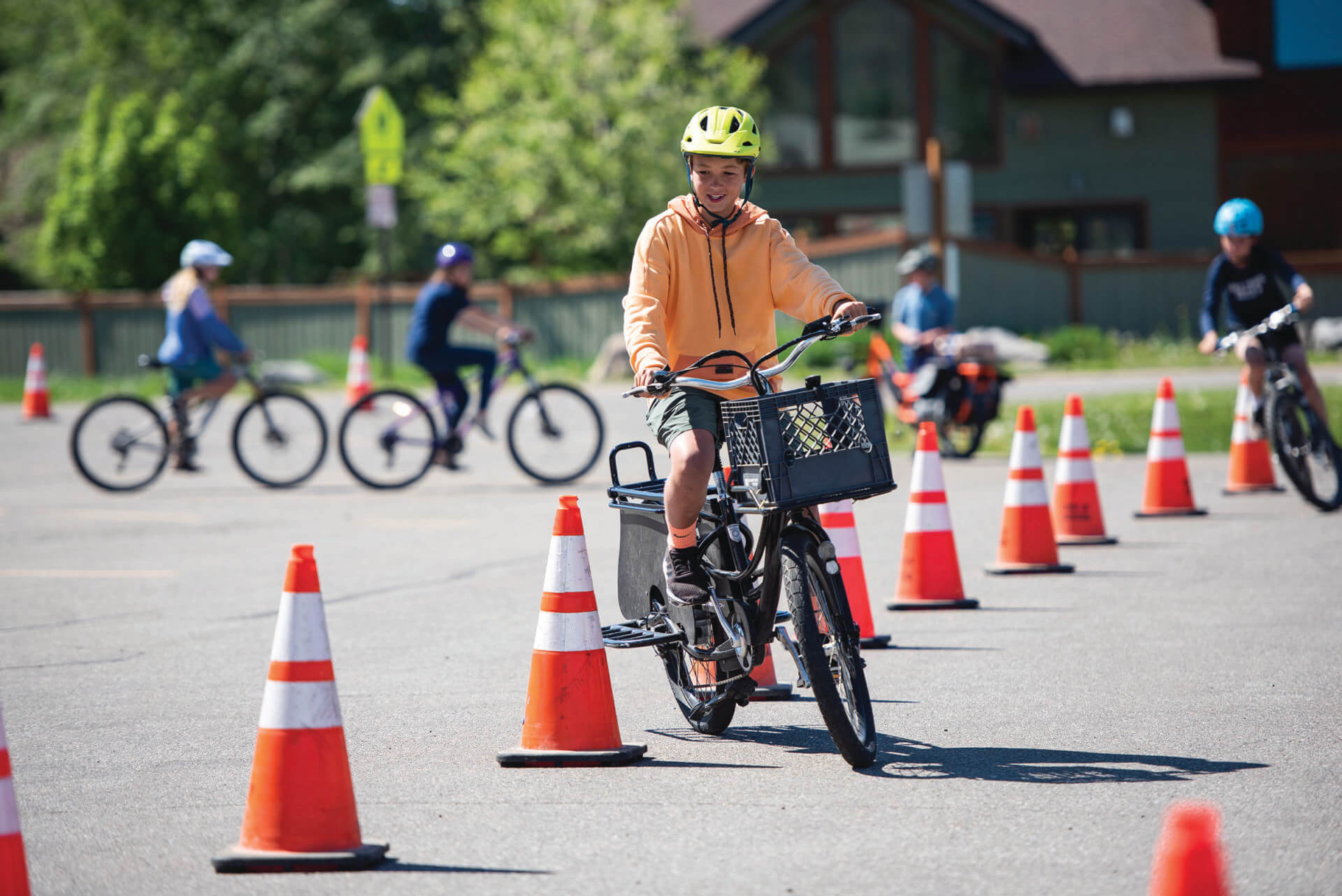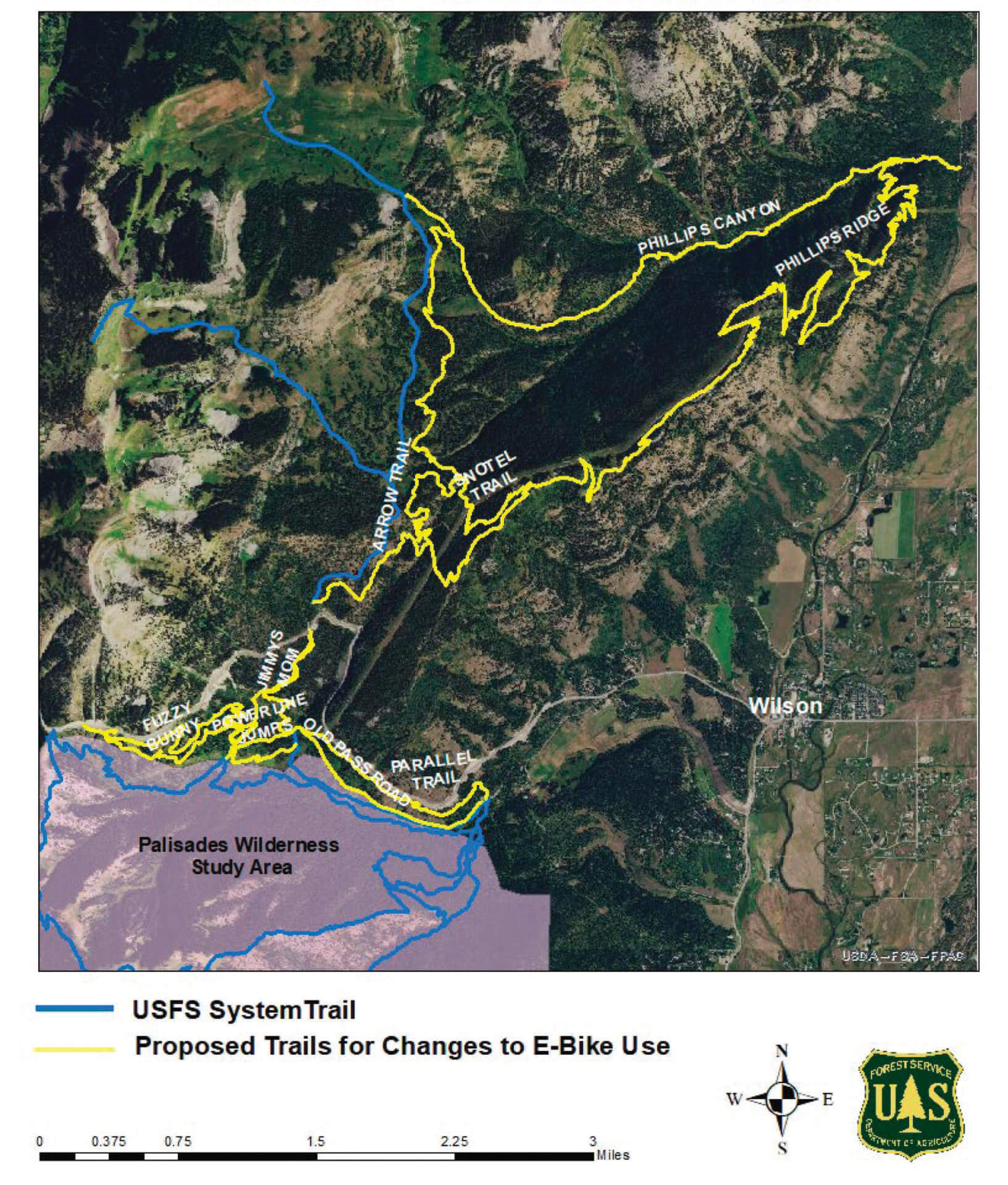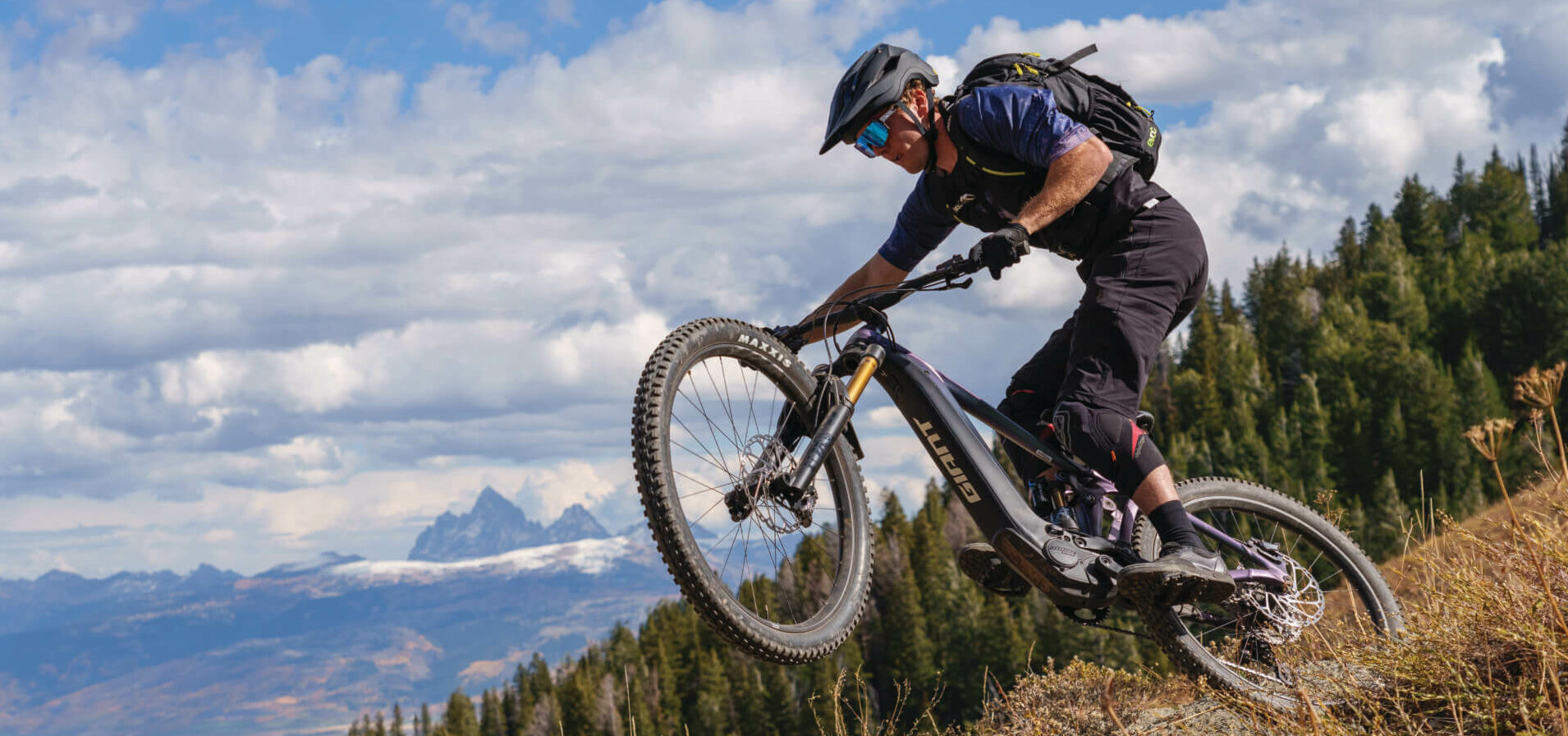Read The
Current Issue
Get a Boost
As e-bikes explode in popularity, Jackson Hole is trying to figure out where they should be allowed.
// By Molly Absolon
Midway up the initial steep, gravelly climb out of Grove Creek in Idaho’s Big Hole Mountains, I heard a polite cough behind me. Startled, I pulled my bike off to the side, glad for a chance to stop, catch my breath, and let my pounding heart slow down. A pair of cool-looking (as in not huffing and puffing) bikers pedaled past. One glance at the bottom tubes on their bike frames told the story: they were riding electric mountain bikes, or e-MTBS, and they looked like they were having fun. Real fun. Not the kind of “fun after it’s over fun” that I was experiencing.
E-bikes, bikes that provide their riders with battery-powered assistance, are everywhere these days. In 2022, 1.1 million e-bikes were sold in the United States—four times more than in 2019—according to the Light Electric Vehicle Association. In dollar terms, that represents a jump from $240 million (2019) to $885 million (2022). New technology has made e-bikes both more affordable and more capable, which in turn are leading to an increasing number of e-bike converts.
“E-bike sales are approaching half of our business now, which is crazy. But it makes sense. E-bikes are fun. Everyone who takes one for a test ride comes back to the shop with a smile on their face.
We joke that you shouldn’t try one until you want to buy one.”—George Flynn, e-biker and co-owner of Open Range Cycles
“I’d say e-bike sales in the shop have been growing around 100 percent per year,” says George Flynn, who owns Open Range Bicycles (formerly Fitzgerald’s Bikes) in Jackson with his brother, Bart, and business partner Greta Baker. Flynn is an avid cyclist who has two e-bikes in his personal bike quiver. “E-bike sales are approaching half of our business now, which is crazy. But it makes sense. E-bikes are fun. Everyone who takes one for a test ride comes back to the shop with a smile on their face. We joke that you shouldn’t try one until you want to buy one.” E-bikes allow older, less fit, and disabled people to get out on bicycles. E-bikes act as levelers, allowing riders of different abilities to be together and have fun without slower folks feeling anxious and stressed about keeping up with their speedier friends. People can ride farther or tackle more demanding trails with a little battery boost.

The arrival of e-bikes has not been without controversy, and for every convert, there is a detractor. People complain about kids on e-bikes going too fast while riding on the paved pathways around town, texting while riding, or riding on roads while carrying multiple passengers and not following traffic signs. Some hikers, horseback riders, runners, and mountain bikers on non-e-bikes are upset about e-bikers riding trails on which motorized users are not allowed. (Almost all singletrack trails on the Bridger-Teton National Forest surrounding Jackson Hole, which includes the Snow King and Cache Creek Trail Systems and the Teton Pass Trail System and Old Pass Road are currently not open to motorized users; this includes both motorcycles and e-bikes.) There is also fear that the e-bikes will cause more conflicts with wildlife and worries that they will damage trails. People think speed differences between user groups could lead to more accidents.
Are these concerns legitimate? And which are part of the normal growing pains that happen when new technologies are adopted?
Aaron Nydam is the bike-safety coordinator for Friends of Pathways in Jackson. The bulk of his work recently has been focused on e-bikes. Nydam says e-bikes have brought Jackson’s youth incredible freedom and mobility, which is a good thing. However, without education, that freedom and mobility can be easily abused. Fair or not, middle-schoolers have borne the brunt of Jackson’s anti-e-bike sentiment when it comes to paved pathways. “Kids deserve some of that criticism,” Nydam says. “But mostly the issue comes down to a lack of education. E-bikes don’t require any kind of license to ride, so kids can ride them without any training. But the bikes are powerful, and they require skill and education to operate safely.”
“E-bikers are treading on thin ice. People are watching us, and looking for negative interactions
to back up their negative opinions about e-bikes. We need to ride e-bikes in the right places and lead
by example to show other users we can play well.”—George Flynn, e-biker and co-owner of Open Range Cycles
In 2023, in response to growing public concern about kids on e-bikes, Friends of Pathways initiated a bike-safety program at Jackson Hole Middle School. The program focuses on bike-handling skills and lets kids practice negotiating turns and controlling their speed on both e-bikes and regular pedal bikes with supervision from more experienced riders. The program also includes an introduction to basic bike maintenance, so kids learn how to make sure their bikes are operating properly.
Nydam says pathway conflicts can usually be attributed to user etiquette, lack of attention, or ignorance. The goal of the pathways’ program is to address these issues early in a biker’s career so they can establish good habits. He says pathway etiquette is ultimately about being nice.
Etiquette can also go a long way toward alleviating concerns about e-bikes on naturally surfaced (i.e. dirt and gravel) trails. Currently, e-bikes are forbidden on most of the trails around Jackson. Riders in Teton Valley, Idaho, have more options, with most of the Big Hole Mountains, which are part of the Caribou-Targhee National Forest, open to motorized, and, therefore, e-bike, use. But Jackson Hole e-bikers don’t have a lot of trails to ride, which means people have resorted to riding their e-bikes illegally, raising the ire of other trail users. “E-bikers are treading on thin ice,” Flynn says. “People are watching us, and looking for negative interactions to back up their negative opinions about e-bikes. We need to ride e-bikes in the right places and lead by example to show other users we can play well.”
In 2023, the Bridger-Teton National Forest began studying a proposal to open a limited number of trails on Teton Pass to e-bikes without throttles and to extend the season when throttle-less e-bikes are allowed on the Horsetail Creek Trail in the Gros Ventre Mountains and on the trail system around Munger Mountain. The idea is to provide more opportunities for e-bikers in Jackson Hole. A decision on the proposal is expected by the end of 2024 or early in 2025.

Courtesy of USDA Forest Service
Tim Farris, the BTNF’s trails and wilderness program manager, says the proposal stems from user demand, as well as direction from forest service leaders for local agencies to examine the e-bike issue on their districts. The BTNF’s Jackson Ranger District is one of the first in the country to dive into the issue, according to Farris. “The majority of forest service trails were originally designed for pack and stock use,” he says. “Over time, demand has changed. We can’t do everything for everyone all the time, but we can make sure there are a diversity of opportunities on the forest. This proposal is about looking at options for possible e-bike use.”
The forest’s proposal, which would open 27.5 miles of existing trails on Teton Pass—out of nearly 800 miles of trails in the Jackson District—garnered 342 public comments. Farris is quick to say these numbers are not a vote, but they do provide a useful framework of concerns that need to be addressed as the process moves forward. “The concerns people raised have really helped us drill down into what needs to be considered,” he says. “There’s a lot of misinformation out there about e-bikes. E-bikes on pathways are very different from e-bikes on trails. E-bikes on pathways can be scary, and a lot of that fear is being transferred to concerns about trails.”
Most of the research on e-bikes on trails shows those fears are misplaced. For example, studies have shown that e-MTBs and regular mountain bikes impact trails similarly. Concerns about speed on naturally surfaced trails also seems to be inflated. E-bikes do go faster uphill, but their speeds are hardly out of control. A 2019 study conducted by researchers at Brigham Young University showed that the average speed of regular mountain bikers on a specific trail was 8.8 miles per hour, while e-bikers on the same trail averaged 12.9. That difference is definitely significant—especially when huffing and puffing up a long climb—but on descents, where speed is more likely to cause problems, regular mountain bikers are often faster.
“Most user conflicts can be explained by the theory of goal interference,” Farris says. “People have different goals. You may want exercise, you may want to socialize, or you may want solitude. When two people go out with different goals, that’s when you have conflicts. Are our trails overcrowded? I think it depends on the day, the season, and the place. On a Monday at 9 a.m. in Cache Creek, you may not see anyone else, while at 5:30 p.m., it may be mayhem there. Living here you learn where to go to get what you are looking for.”
What more and more people seem to be looking for is an opportunity to ride their e-bike close to town on trails designed for traditional bicycles. Celeste Young, who lives in Victor, Idaho, has been a biker all her life. Recently she added an e-MTB to her fleet of bicycles. “The most negative thing I’ve heard is, ‘Oh, you’re cheating,’” she says. “But it’s just another way to be out there. You get an extra boost going up these really hard trails, so it makes a challenging trail fun, rather than demoralizing.”
Tips for Parents of e-bikers
1. E-bikes can be as heavy as 70 pounds, which can make them unwieldy for smaller riders. Always consider the weight and size of both the bike and the rider when purchasing an e-bike. Riders should practice stopping and steering to get used to an e-bike’s greater mass and force.
2. Talk to your kids about the importance of helmets, communication, hand signals, situational awareness, visibility, kindness, and valuing others’ experience and safety when they’re riding an e-bike.
3. The town of Jackson requires all e-bikes to be registered with the police department within 30 days of purchase. In addition, Jackson Hole Middle School requires a parking sticker for e-bikes. To obtain a parking sticker, riders must complete a pathway safety course and pass a test.
This has been adapted from materials created by Friends of Pathways, friendsofpathways.org
E-bike classifications
Class 1: 20MPH – max pedal assist, no throttle)
Class 2: 20 MPH – max pedal assist, throttle)
Class 3: 30 MPH – max pedal assist, no throttle)
The speed limit on the Town of Jackson’s pathway network is 15 mph; in selected congested areas it is 10 mph. JH





